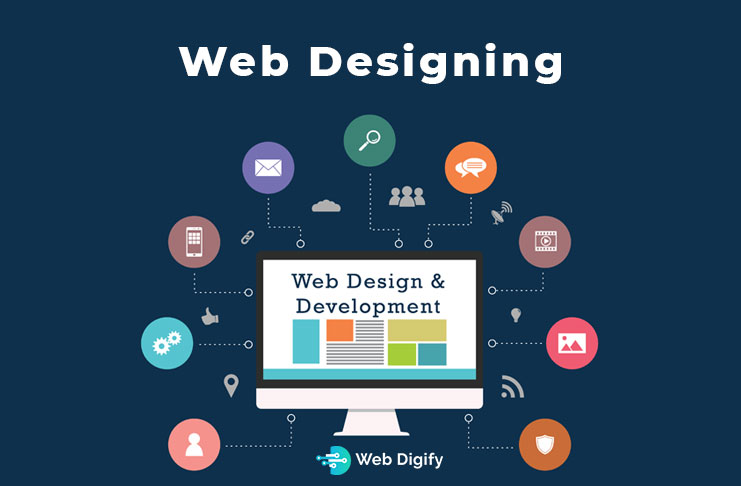Millions of Poles actively use the Internet every day. That being said, if you run any kind of business, having a well-designed, professional website should be a must.
Company website – a showcase for every business
It doesn’t matter if it’s a simple business card website, landing page, large online store, or an extensive website full of various content – a good website for companies is your great asset. It helps to maintain a relationship with current customers, reach thousands of potentially interested parties, gain credibility in their eyes, build trust and improve your image. It is also much greater marketing opportunities – without a website, you have practically no chance to surpass your better-prepared competition, regardless of the industry in which you operate.
Marketing and analytics with the help of a website
Your own website gives you more control over your marketing activities and the opportunity to learn about your customers’ needs. After all, all advertising campaigns on the internet should be directed somewhere. Thanks to this, you have a chance not only to positively influence the recognition of your brand but also to increase the number of conversions, which translates into real profits from the campaign. The better the advertisement and the more carefully designed website, the chances for an increase in sales increase.
Thanks to the website, you can also learn more about potential customers and use this knowledge in the further running of your business. By implementing analytical tools inside your website, you will learn who visits your website most often and which people are converting. You will learn the phrases and sources from which users come to your website, you will learn which elements of the website are the most popular, and what you can do to attract customers to your website even more effectively.
Web design and Website development – stages
A website for companies does not come into being overnight. The whole process consists of several stages and usually involves a whole team of people from various specializations. At the very beginning, before the website design is created, it is very important to perform a preliminary analysis of the client’s needs, discuss the purpose of creating the website, the direction of activities, and potential expectations.
The client will have completely different expectations for the business card side, and different for the project that is to gradually build his image. At this stage, the initial concepts of the website appearance, navigation system, planned solutions, as well as the type, number, and layout of subpages are discussed by our team at web design. It is also time to analyze your competitors and their websites.
The next point is Web design
At this point, a graphic design is created that takes into account all the needs and requirements of the client and is in line with trends both on the Internet and in a specific industry. The mockup also contains elements important in terms of SEO and UX. After consultations, any corrections are made, and after approval by the client, further works are started. In the meantime, content is commissioned and created to fill the page.
The next step is to decide to implement a CMS system and choose the best solution – you can read about what it entails later in this article. Code is created and internal tests are performed. At this point, you should also choose the appropriate domain, i.e. the internet address where your website will be located, and then register it.
Ideally, the domain should be functional (i.e. short and easy to remember) and relate to the name or nature of your business. A good decision will be to choose a domain with the .pl extension because they usually inspire more trust among users.
Last Step
The last step before launching the website is choosing the hosting, i.e. the place on the servers. Every site needs to store all its data somewhere – files, photos, documents. They should be available all the time, so hosting services should be selected with due care. Servers should guarantee data protection and offer trouble-free, efficient equipment, equipped with an additional power source in the event of a power cut in the building. It is not worth trusting free hosting services, which are associated with a lack of protection, failure rate, space limitations and a large portion of ads on the site that you will not have any influence on.
How to manage the content on the website? Choosing a CMS
It happens that people who do not feel confident with their computer skills are afraid that they will not be able to manage the content of the company’s website. Fortunately, thanks to content management systems, you don’t need any advanced programming knowledge to operate your site; you only need basic computer skills.
CMS is software that allows you to publish content inside the website, without the need to delve into the website code. It also enables the handling of forms, modules and many other functionalities simply and understandably for an average user. However, the CMS must be tailored to your needs. If still, you are not ready to handle CMS then you can ask our web design team for this.
One of the most frequently chosen solutions is the Open Source system, made available based on a free license. These include the popular WordPress theme, Joomla! or the more advanced Durpal. These systems have some limitations and their use is made easier by plug-ins. Open Source CMS are very popular for backend sites and simple sites created by beginners.
The second recommended option are dedicated CMS systems – these are tailor-made solutions, created by an external agency, taking into account all the requirements and needs of a specific client. Unlike websites based on ready-made solutions, they are much safer (they have an individual structure and no dedicated hacking tools have been created to facilitate the takeover of the site, as in the case of popular Open Source systems) and have almost no limitations when it comes to functionality. They are a good choice for more complex pages that require better protection.
SSL certificate
Speaking of website security, the SSL and TLS certificates cannot be ignored. It is the HTTPS protocol, which precedes the website address and defines the method of sharing content on the website. It is an encrypted version of the HTTP protocol that protects all data sent between the server and the browser. This makes the connection safe for both you as the website owner and the visitor.
An additional advantage is the fact that the implementation of the certificate improves the website’s credibility, increases traffic, and reduces the bounce rate, which translates into the website’s visibility in search results. So at web design, we use SSL. Since 2011, Google has been supporting the transition of websites to HTTPS, and the importance of this ranking factor is constantly growing. To save yourself the later problems related to the implementation of the certificate, it is worth making this decision at the stage of creating the company website.
A company blog, and creating a leadership position in the industry
If your website is not just a business card, and you want it to help create your image, it’s a good idea to run a blog. Publishing periodic articles related to your industry, written by experts, increases your credibility in the eyes of potential customers and puts you in a leadership position relative to the competition.
It is also a great way to gain additional traffic – the blog has more links, which influences your position on Google and increases the SEO potential of your website. Interesting content attracts people, builds relationships and allows the company to communicate with customers in such a way as to increase the quantity and quality of conversions. In addition, conducting marketing activities inside the blog allows you to reduce costs while improving efficiency.
Not sure what content to post on your blog? Observe the competition, search for topics that will interest your users and cooperate with SXO specialists who will conduct an analysis for you and propose effective content.
The most important elements of the website
What should every website contain? The appearance of the home page is the most important – it builds the first impression of the potential customer and there are the most important information and things that should be noticed in the first place. The logo and company name should be visible at first glance. In this case, it is worth taking care of the website analysis in terms of UX, so that the home page is legible and contains everything that the visitor expects.
Each site also needs a menu, which is the basic navigation within the site. It is not worth trying to be creative here and it is better to rely on proven solutions – this element should be simple and understandable for every visitor. The menu should include tabs such as “about the company” or “contact”.
Important elements also include an information footer, in which there will be other important elements that did not fit in the menu. There you should leave your contact details; you can also use this place to write a short note about the company and place a site map, which will improve navigation within the site for both people and search engine robots.
Responsive websites – advantages
The number of people browsing the internet and making purchasing decisions using mobile devices is growing every year. While until recently smartphones and tablets accounted for a negligible percentage, today they have significantly dominated the source of traffic. The size of devices has also changed over time – phones come in all sizes, from quite small ones to those resembling small tablets. All this means that adapting the website to mobile devices is no longer an asset, but a necessity.
Initially, a popular solution was to create mobile versions of the website, recognizable by the characteristic letter “m” preceding the domain name. However, this option has some problems – the mobile version may not be suitable for devices with higher resolution, and updating the content requires working on two sites.
Responsive pages are created based on several different views. Thanks to this, they automatically adapt to screens of various resolutions, without hindering their viewing. Their unquestionable advantage is the ease of conducting SEO activities – no duplication of content and simpler planning of link building works are not all; Google has officially supported the use of technology on websites.
Company website – optimization and positioning
The website itself is not enough. If you want to find customers, you have to reckon with the fact that they have to find you. In addition to activities in social media or traditional marketing, you must ensure that the website is user-friendly and search engine friendly. What should an optimized website for companies look like?
First of all, website positioning should be started at the design stage. If you don’t take this into account when creating your website, it may turn out that after a month your website will need a major overhaul to carry out any SEO activities at all. By planning everything from the beginning, you will save yourself and the webmaster of the work in the later stages.
All activities should be based on carefully selected keywords, both general and long-tailed. All graphics should have alternative descriptions, and each subpage should have a title and description. In articles, one should remember the hierarchy of headings and proper internal linking.
The website should also be optimized for users. This means that navigating it should be simple and intuitive, and the potential customer will not be overwhelmed by an excess of buttons, colors, and effects.
How much does a website cost for a company?
The price of creating a website for a company depends on many factors. First of all, the level of website development, industry, CMS type, and many other minor elements are important. Unless you have specific requirements, the “sky is the limit” rule applies. You can spend 3,000 as well as 10,000 PLN.
A lot also depends on who you outsource this service to. By using the services of a freelancer, you can easily drown your budget and get a product that, while visually meeting your expectations, may need to be seriously tweaked over time.
By ordering the creation of a professional agency’s website, you can be sure that the service will be performed from A to Z. This means not only an individual graphic design at the beginning of cooperation but also a guarantee of the proper functioning of the website, optimization for SXO, assistance with expansion and advertising consulting and running the website.




